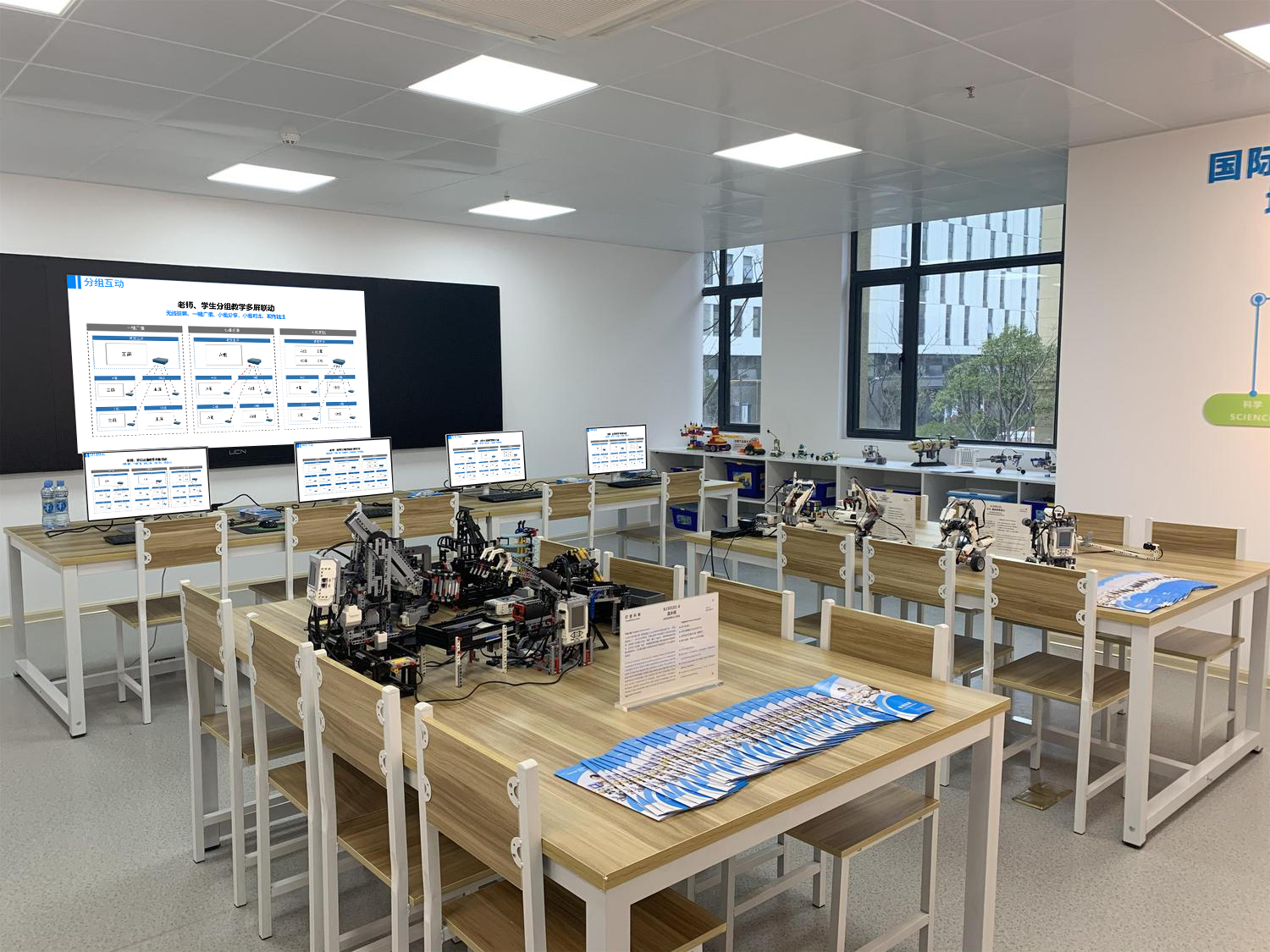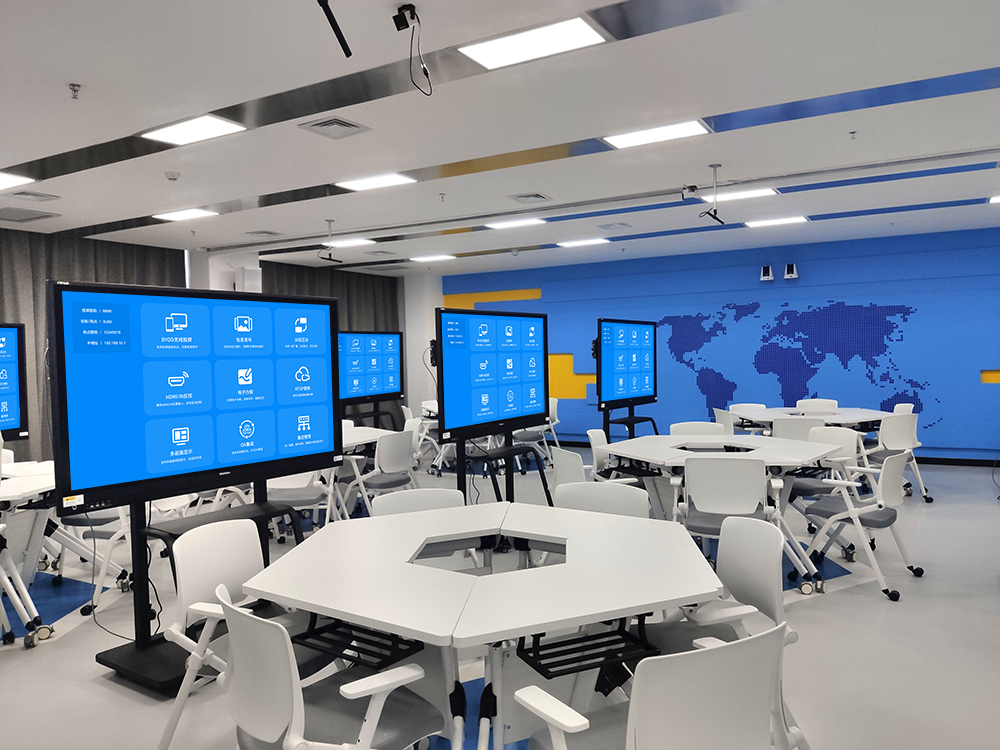Use This for Multi-Screen Collaboration: More Efficient Classroom Device Linking
Does your smart classroom need to break free from the limitations of “single-device mirroring and fragmented interaction”? This screen mirroring device makes it easy to set up a multi-screen collaborative environment! It’s compatible with all teacher, student, and display devices. It supports content flowing between screens, two-way annotations, and real-time synchronization, covering every part of the lesson, from teaching and practical training to discussions. This makes multi-screen collaboration truly empower teaching.
3 Steps to a Collaborative Setting: No Barriers for Teachers and Students
It’s simple to use and quickly gets multiple screens working together:
- Automatic Device Networking: Plug the receiver into the smart board or the main screen. Plug the transmitter into the teacher’s computer. Student tablets and the group’s secondary screens will connect to the campus Wi-Fi. The mirroring device will automatically identify and group the device types, completing the network setup in 10 seconds.
- One-Tap Permission Configuration: A teacher can tap to turn on “Teaching Collaboration Mode,” which will automatically give them “primary control” (for pushing content and controlling the pace) and “interactive permissions” (for submitting results and asking questions), which prevents operations from getting disorganized.
- Start Cross-Screen Collaboration: When the teacher starts mirroring, students can tap “Join Collaboration.” The multiple screens will instantly sync, and lesson plans, annotations, and results will flow in real time. The whole process takes less than 1 minute.
Core Advantages: More In-Depth Multi-Screen Interaction
Content Flows Between Screens for More Flexible Teaching
- Instant Material Transfer: Lesson plans from a teacher’s computer, a mind map drawn on a student’s tablet, and a photo of a hands-on task taken with a phone can be directly transferred with the mirroring device’s “cross-device pushing.” There’s no need to use a USB drive or software to transfer them, which boosts the efficiency of summarizing by 70%.
- Collaborative Editing: A teacher can mirror a lesson plan from their computer to the smart board, then use a tablet to walk around the classroom and continue to annotate. The annotations will be synchronized back to the computer and student screens. If a student doesn’t finish their homework, they can switch to a public classroom tablet and continue editing it. There are no interruptions in collaboration.
- Complementary Multi-Screen Display: The main screen can mirror the core content of a lesson plan, the side screen can mirror a video of an experiment, and the group’s secondary screen can mirror their discussion results. The three screens work together to show theory, practice, and ideas at the same time, giving students a more thorough understanding.
Two-Way Interaction for a More Engaging Classroom
- Unrestricted Two-Way Control: After a teacher uses their computer to control the mirroring, they can use their phone to remotely flip pages and pause. When a student has a question, they can annotate “I don’t understand this” on their tablet and push it to the teacher’s device in real time, so the teacher can provide a more precise explanation. This helps students who are hesitant to ask questions.
- Real-Time Annotations: During a group discussion, a team member’s annotated suggestions on a tablet will be synchronized to the group’s secondary screen. The group leader can lock key ideas. When the class is giving feedback, the teacher’s annotations on the smart board will automatically be synchronized to all student devices, making feedback more timely.
- Dynamic Data Synchronization: Student answers and participation frequency are automatically summarized with the mirroring device and displayed on the main screen as a chart. The teacher can get a clear picture of how students are doing and adjust the lesson’s pace.

For All Scenarios: Multi-Screen Empowers Smart Teaching
Daily Teaching: Boosting Both Efficiency and Interaction
- In a Chinese class, a teacher can use a computer to mirror an illustration from a textbook to the main screen, and a student can take a photo of their own drawing with a tablet to mirror it for comparison, which deepens their understanding. In a math class, a teacher can mirror a geometric shape to the main screen, and a student can use a tablet to drag the shape to demonstrate a theorem, making abstract concepts concrete.
- In an English class, a teacher can push a listening exercise to the speaker, and a student can use a tablet to scan a QR code to answer. The results will be mirrored in real time, and questions that are often answered incorrectly can be pushed to the group’s secondary screen for a focused explanation.
Practical Training: Synchronized Practice and Explanation
- In an auto repair class, a teacher can use a computer to mirror a video of a device being taken apart to the main screen. When students are doing a hands-on exercise, they can take a photo of the details with their phone and upload it. The teacher can annotate the mistakes on the main screen without having to check each station, which is more efficient.
- In a design class, a student can draw a design draft on a tablet and mirror it. A teacher can use a computer to push a reference case study at the same time and annotate to suggest directions for improvement, which makes professional guidance more precise.
Discussions: More Thorough Idea Exchange
- For a group project, each group can mirror their report to a secondary screen to get feedback from their peers. Excellent work can be pushed to the main screen with a single tap. A teacher can use a tablet to push supplemental materials and add their own views, making the discussion more in-depth.
- A remote expert can use a computer to connect to the mirroring device and view the multi-screen content in the classroom in real time. They can push their feedback to the main screen, and the team can work on the lesson plan together.
Secure and Stable: Peace of Mind for Campus Use
- The dual-band transmission has strong anti-interference capabilities. When multiple devices are collaborating at the same time, latency is less than 15ms, and the disconnection rate is less than 0.1%. A public class won’t be interrupted. It works with the campus system, so only authorized devices can connect, which protects the class order.
- The mirroring device is only the size of a palm and weighs less than 40g. A teacher can easily put it in a computer bag for an outdoor study session and set up a mirroring environment anywhere. It supports a batch management platform for unified device configuration, which lowers maintenance costs.
By using this screen mirroring device to enable multi-screen collaboration in a classroom, you can make devices go from being used individually to working together. Teaching becomes more flexible, and students become more engaged, which truly activates the value of a smart classroom.